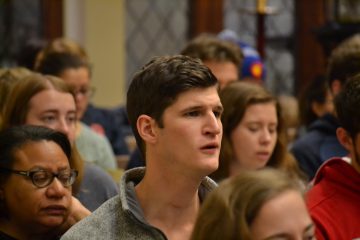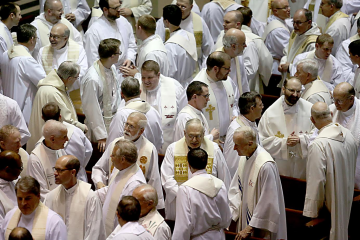Sunday Scripture: Has anyone seen God and lived?
Wednesday, June 10, 2009
By Sister Betty Jane Lillie, S.C.
Most Holy Body and Blood of Christ: Exodus 24:3-8; Psalm 116:12-13, 15-18; Hebrews 9:11-15; Mark 14:12-16, 22-26
In last Sunday’s reading we had the question, “Has anyone heard the voice of God and lived?” The answer, of course, is “Yes.” In this week’s passage the text just following our first reading puts a popular assumption of the time to rest: it was believed that one who would see God would die. In our reading we see that the elders beheld God and were still able to eat and drink of the sacrificial meal. So, to the question as to whether anyone who sees God can live, the answer is “Yes.”
The covenant ritual related in today’s first reading is situated in the text between two episodes that indicate that God was with His people and the covenant was made in the context of that presence. (Exodus 24:1-2 and 24:9-11) The bipartite aspect of the covenant is explicit there. God is symbolized by the altar and the people are represented by the twelve pillars.
The unifying term is the blood that was sprinkled on both altar and people. Blood is a powerful term because it is essential for physical life, and so it is a precious symbol that was used in the Hebrew Scriptures as well as in the paschal mysteries of Jesus’ death. In the Exodus it saved the lives of the first-born of the Hebrews, and thus had a propitiatory significance. In our reading it was the blood of holocausts offered as peace offerings. In both cases there is a significance that carries over to Jesus’ redemptive act of shedding His own blood for the salvation of the world.
The author of the Letter to the Hebrews draws a contrast between the blood of animals used in the Hebrew Scriptures and the blood of Christ that won eternal redemption, cleansing our consciences from dead works to worship the living God. Thus Jesus is mediator of a covenant that brings eternal inheritance for all who are called. How much more efficacious is the unblemished blood of Christ who offered himself through the eternal Spirit in propitiation for the sin of all humankind!
As we reflect on the Letter to the Hebrews we can almost feel the process of salvation history moving toward its epitome in the Gospel tradition. In the Gospel of Mark the meal is given as a Passover meal, celebrated on the day when the Passover lamb was sacrificed and eaten. The terms body, blood, and remembrance call up important elements of Christian theology.
“Body” refers to Christ’s body given up for us, as well as to Paul’s application to the people/body who form the unity that is identified with Jesus as the mystical body of Christ. (1 Corinthians 12:12) “Blood” is contained in the eucharistic cup and links the concept of suffering to Jesus’ paschal mysteries. His blood was given up for us on the cross. Thus the Eucharist is the thanksgiving sacrifice of the New Testament in which we participate as a Communion sacrifice. “Remembrance” finds expression in the bread and wine of a Passover celebration that is associated with the bread and wine of the Last Supper. It becomes the body and blood of Christ. Jesus instructed His disciples to do the same actions he had done in memory of him.
We can put all of this together (“re-member” it) in our own thoughts by remembering the psalmist’s prayer: “What shall I return to the Lord for all His bounty to me?…I will offer to you a thanksgiving sacrifice and call on the name of the Lord.” (Psalm 116)
Sister Betty Jane is a faculty member at the Athenaeum of Ohio.





![The night is advanced, the day is at hand. Let us then throw off the works of darkness [and] put on the armor of light Romans 13:12 Rorate Mass Old St Mary (CT Photo/Greg Hartman)](https://www.thecatholictelegraph.com/wp-content/uploads/2018/12/DSC_0569a-360x240.jpg)



